- Cards
- List
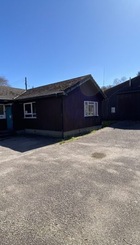
Creating a Cairnbaan Community Hub. Refurbishment of the old forestry buildings
2025-05-30 • No comments • • Regeneration Capital Grant Fund
1. What we want to achieve.
The Cairnbaan Community Trust, (SC052905) wants to refurbish the forestry buildings to provide a community gathering point and flexible workshop and event spaces. We want a community hub that can be used by the community for education such as crafts and Gaelic, health e.g. yoga and other activities, recreation and social gatherings, inside and outside and temporary office space for local entrepreneurs.
Our priority is the smaller of the two buildings which will provide space for community events and workshops, social meeting space, hot desks and a community kitchen. There is external space that can be developed to provide a community garden and outside event space. It is hoped in the future the larger of the two buildings can be developed to provide space for larger workshops and events.
We have divided the work into phases and we are currently seeking funding for phases 1 and 2.
Phase 0: This covers the procurement of the forestry buildings under a community asset transfer funded by the Scottish Land Fund and we have secured initial funding for essential repairs to both buildings to make them safe and weatherproof. The work will start when we take ownership on the 01/08/2025.
Phase 1: Is the refurbishment of the smaller building. This phase will change the internal layout of the building to create flexible spaces. This entails new partitions, doors, lighting and upgrade to the heating. Additional facilities, external and internal, will be needed for disabled and users with special needs. We also aim to fit a community kitchen and social space for coffee mornings. Finally we need to replace windows and install new furnishings and fittings.
Phase 2: Is the landscaping and provision of a community garden and outdoor space.
Phase 3: Is the refurbishment and fitting out of the larger building. In this phase we also plan to look at energy efficiency improvements, e.g. heat pumps and solar panels.
2. Why our project is needed
Currently there is no community centre to provide a focal point or resources for the community. There is a risk of social isolation amongst our older population and there are no facilities for the young people in our village. Community cohesion is being eroded.
We commissioned a feasibility report through Community Enterprise which highlighted the following points. Accessing facilities is difficult without a car, the minimal bus service is a school service with no evening or Sunday services. There are no shops, medical or other services in the village. Despite scoring highly in other domains the area falls into the 10% most deprived areas in Scotland in terms of access to services in relation to the Scottish indices of multiple deprivation. Feedback from local people highlighted that a primary need in the community is an indoor social area and meeting space.
3. The positive changes our project will bring
Our vision is to reduce isolation, improve community life and reflect the cultural, environment and historic heritage of the area. The current priorities for the CCT are.
- Bringing the community together to enable opportunities for social interaction and growth.
- Advancement of arts, heritage, culture and science.
- The provision and organization of recreational facilities to improve the quality of life for the community.
- Improving the environment including education about the environment, culture and history.
- The relief of thos in need either because of age, ill health, disability or financial hardship.
The refurbishment of the buidings will provide a focal point for the community and the resources to bring the community together especially those that feel isolated. It will provide resources for all ages across the community and give everyone opportunities for development and a sense of purpose and indentity.
Through current engagement with the local community we have already identified skills and volunteers that can contribute to the refurbishment which will foster community involvement from the outset
4. How long will our project run
Phase 1 and 2 of the project will start on: 05/01/2026
The project will run for: 15 months
Our Business plan and the Feasibility report are available on request. Unfortunately the file size was too big to attach.
Tiree & Coll Community Vet Practice Project
2025-05-30 • No comments • • Regeneration Capital Grant Fund
What do we want to do?
This project seeks to transform an existing community space at the Tiree Rural Centre – previously used as a café – into a community-owned vet practice serving the islands of Coll and Tiree. The Rural Centre hosts the island’s cattle and sheep market along with an exhibition showing all aspects of crofting and wildlife on Tiree. It plays a leading role in preserving Tiree’s rich crofting heritage and, together with its central location on the island, is well-placed to host a community vet practice. This represents a significant investment and regeneration project for both Tiree and Coll, and would contribute positively to local economies, which revolve around crofting.
This project is led by a consortium of island stakeholders which includes Tiree Rural Development (which manage the Rural Centre), Tiree Community Development Trust, various crofters and community representatives, and the current vet. This steering group provides strategic oversight and represents a community-led approach focused on safeguarding a key island service and a shared belief that something must be done before it is too late.
To that end, the Tiree Community Development Trust commissioned a feasibility study to investigate renovating the available, currently vacant space at the Rural Centre into a vet practice. With a full design and accurate costs now in place, the consortium are now in a position to commence a build phase of the project, and are actively seeking funding to make this important project a reality.
Why is our project needed?
A vet is absolutely critical to both Tiree and Coll. Without an island vet, crofting largely becomes untenable, as crofters need access to veterinary services to keep animals and ensure their welfare. Crucially, Tiree’s culture, history, economy, and its unique machair landscape are all strongly linked to crofting. In addition to running their crofts, crofters often hold multiple jobs and community roles, and are essential to island life.
As crofting is the island’s primary industry, the loss of a vet would have dire consequences for the local economy. This would likely lead to emigration and a decline in the numbers of families living on the island. Even a few families leaving would have a significant impact on services, and could spark the further closure of lifeline services such as the school, GP surgery, and local businesses – a gradual process often seen in other small Scottish islands once the population falls below a critical point. Once these key services are lost, we know from experience and research that they rarely return. This is due to the high cost of running services on islands, the challenges of setting up, and the dwindling economic returns and economies of scale. Remote islands are places where market failure is the norm, not the exception. The group recognises that the vet practice is one such service that the island cannot afford to lose.
Moreover, many residents keep small animals and pets; the operational and cost implications of relying on a mainland vet service for Tiree and Coll residents are significant, in some instances prohibitive. The vet also plays a central role in protecting the island’s unique wildlife and marine life, regularly attending call-outs to help stranded dolphins and seals, for example.
With our current vet looking to retire in the near future, we are keen to minimise barriers that an incoming vet faces. In the past, it has been difficult to recruit and retain vet capacity, and recent shortages in the sector, combined with a low financial return of investing in an island-based vet practice, have made this challenge more acute. Additionally, the current vet operates out of a small and temporary space which is unlikely to meet future RCVS standards and does not fully meet the dynamic needs of an island vet. A high-quality, affordable, and long-term practice ensures that the prospect of moving to Tiree to take over the practice becomes much more attractive and financially viable.
What positive changes will our project bring about?
This project provides key benefits to crofters and the wider community on both Tiree and Coll:
- A bespoke, compliant, and modern vet practice will make it easier to attract an incoming vet to the island, and retain them once they have arrived.
- It improves the standard of care and contributes positively to animal welfare, as well as providing a better space for a vet to operate out of.
- Securing an appropriate practice space for Tiree and Coll safeguards the entire crofting sector, the island’s primary industry.
- Security of tenure for the vet, as well as a stable rental income for a community group dedicated to improving conditions for crofters and wildlife on Tiree.
- Making better use of existing assets, and optimising design to factor in environmental improvements.
- Tiree and Coll pet owners are guaranteed access to veterinary care without having to rely on mainland services, which can be difficult and expensive to access – especially during emergencies.
- The project contributes to the wider regeneration of Tiree’s existing community-owned assets, and will play a key role in Tiree Rural Centre’s future.
- A lifeline island service is maintained, contributing to the overall viability of Tiree’s small, unique, and thriving community.
How long will our project run for?
The project will start on: 01/03/2026
The project will run for : 12 months
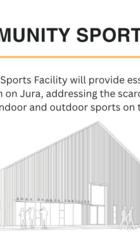
Jura Community Sports Facility - Project Aspiration
2025-04-10 • No comments • • Regeneration Capital Grant Fund
The new sports facility will be suitable for all weather conditions and will enable the playing of various sports on the same surface, including five-a-side football, netball, basketball, and shinty practice.
The Jura Community Development Plan, produced by the Jura Development Trust, highlights the necessity for improved youth and recreational facilities on the Island and concludes that further investigation is required regarding the preferred nature of these facilities.
Developing community-owned and managed assets is strongly supported by national and local policy.
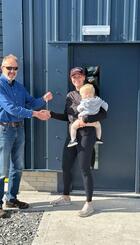
Nonhebel Park (Final Phase)- Community Regeneration in Action
2025-05-30 • No comments • • Regeneration Capital Grant Fund
The Project: We want to develop the final piece of community owned land available at Nonhebel Light Industrial Park, Tobermory to build up to two additional business units. The new units will be for rent to businesses which are on a waiting list for space at the site. Project Background & Need: In response to community identified need for small business premises, community led rengeration charity, Mull and Iona Community Trust developed and now manages 38 business units plus fenced compounds, supporting 24 local businesses and an estimated 61 jobs. There is a waiting list for the units still, proving market failure and the need to develop the final piece of land on the site to further support local businesses and economic regeneration in North Mull. Project Outcomes: Positive Changes: New business units supporting a minimum 2 businesses and up to another 8 local jobs. Improving access to services, tackling rural poverty and population decline by supporting business expansion, start-up and employment; improving family incomes and making the island a more vibrant and sustainable place to live and work. Project Timescales: Subject to securing funding, work to start in late 2025 and complete in Spring 2026. Highland and Island Enterprise are a project partner with a funding offer in the region of £200k.
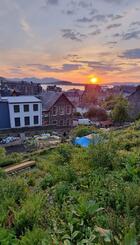
Creating a Community Growing Space in Oban Town Centre
2025-06-02 • No comments • • Regeneration Capital Grant Fund
This project meets RCGF criteria: address vacant / derelict land as well as supporting locally developed, place-based regeneration projects that involve local communities, helping to tackle inequalities and improving the economic, social and physical environment of deprived, disadvantaged and fragile remote communities across Scotland. It is community led, and will result in strong regeneration outcomes.
The Rockfield Garden is leased and run by Oban Communities Trust, a Community Benefit Society run by and for its members and the wider community.
We are transforming a disused, previously cultivated food production area into a vibrant and inclusive community growing space, but need funding to realise our vision. This project is rooted in a growing community movement: over the past year, more than 1,100 volunteer hours have been contributed at The Rockfield Garden. The momentum is clear—and this garden will be a living, growing symbol of community action.
The space, located behind The Rockfield Centre, was previously used to grow fruit, vegetables, and flowers for the former McTavish's Kitchens, but has since lain derelict.
What will your project do? Over the last 12 months a 25+ band of volunteers have spend over 1000 hours on Phase 1, preparing the space for cultivation. We are now seeking funding for Phase 2, which will initiate food production and support both experienced and novice growers, fostering strong community involvement.
- Installing fencing and handrails to ensure safety and accessibility
- Building raised beds and flexible growing spaces for communal and individual use
- Constructing a weatherproof meeting shelter and a secure tool shed.
- Providing tools, gardening equipment, seeds, compost, and plants.
- Developing a community composting system to promote circular growing practices.
- Installing bee hives, chicken coops, and a community orchard
- Offering a varied programme of community engagement and educational growing activities, including informal social gardening drop-ins, volunteer action days, and community education.
Why is your project needed? Oban currently has no community growing provision, and local residents lack accessible opportunities to grow, learn, and contribute. As a rural town we are also heavily reliant on imported food, reducing local food resilience and creating disproportionately high food mile loadings. This project will:
- Provide the community with growing space, tools, and support to grow food locally.
- Encourage healthier lifestyles and increased social connection through shared, hands-on activity
- Respond to the pressing need for increased food resilience in the face of climate change and supply chain vulnerabilities.
- Help diversify the town’s food sources, reducing reliance on imported produce and associated transport emissions.
- Create a learning hub to build knowledge and practical skills in sustainable food growing, composting, and ecological gardening
- Offer a mix of communal and some individually managed plots, providing flexibility to suit different needs and abilities.
- Enhance community cohesion and empowerment through participation, ownership, and shared outcomes.
- Contribute to the Rockfield Centre's mission to reduce its carbon footprint and provide wholesome, healthy, affordable community meals.
What positive changes will your project bring about? The Rockfield Garden will deliver wide-ranging benefits across environmental, social, and educational areas:
- Environmental Impact: With an estimated growing area of 1,400m², there is potential to produce 2,000–3,000kg of fruit and vegetables annually. This local production could reduce food miles and cut an estimated 3–4 tonnes of CO₂ emissions per year.
- Food Resilience: In light of climate change and global food supply threats, local food production is a vital adaptation strategy. Growing food locally in Oban will contribute to community-level food security and resilience.
- Health and Wellbeing: Access to growing spaces and outdoor activities supports mental and physical wellbeing. Gardening fosters regular physical activity, better nutrition, and emotional connection to nature.
- Learning and Empowerment: Hands-on education will equip participants with valuable skills in food production, sustainability, and ecological stewardship.
- Community Cohesion: The project will bring together people of all ages and backgrounds, strengthening social bonds, reducing isolation, and building a sense of place and purpose.
- Sustainability: By incorporating composting and circular practices, such as seed saving, the garden will serve as a practical example of sustainable community living. By transforming this underused land into a thriving garden, we’re not just growing food—we’re growing community, resilience, and shared futures.
How long will your project run for? This is a long-term project that is ticking along in Phase 1, but requires substantial funding to move to Phase 2. Once funded, we anticipate c. 1 year to do the required structural works. We anticipate the total works requiring c. 70k, including staff time, but would gladly accept smaller amounts of funding which would allow us to complete the project in a modular fashion.
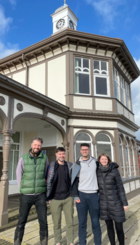
Dunoon Pier
2025-03-26 • No comments • • Regeneration Capital Grant Fund
Operating under the governance of the Dunoon Community Development Trust and in partnership with Argyll and Bute Council, the Save the Pier working group has been actively seeking funding and carrying out further research to progress the necessary technical studies needed to inform these types of developments.
The initial goal of the working group is to develop a robust, evidence-based feasibility study, providing a clear case for the pier’s redevelopment and its potential role within the future of the town’s wider marine infrastructure. Longer-term they hope to begin the process of the pier’s renovation.
The wider team —comprising volunteers with expertise in public sector infrastructure, finance, heritage preservation, project development and community engagement —has been engaging with stakeholders in the public and private sector, having discussions with potential funders, and laying the groundwork to ensure any future redevelopment is viable and sustainable.
Our Progress So Far
The project has involved extensive positive collaboration with Argyll and Bute Council, alongside wider stakeholder consultations, a public petition, and collaboration with advisors in major infrastructure, heritage conservation, and funding options.
Community Involvement
Community engagement will be essential to shaping the pier’s future. There has consistently been a lot of interest on social media and in the newspaper with large numbers of people getting behind the idea of Dunoon Pier being regenerated. It is clear that there is good community support for the idea and the working group welcomes the input of local residents, businesses, and local organisations as the project evolves.
At this stage, the focus is on gathering the necessary technical and financial evidence to determine what is achievable.
Next Steps
Funding is currently being secured to complete a feasibility study, which will provide a comprehensive assessment of the pier’s future potential. This study will form the foundation for securing funding to progress any future redevelopment. However, given the scale of the project, careful planning and a phased approach is required. We aim to complete this initial phase and be in a position to share the feasibility study by Summer 2025.
Looking Ahead
Public infrastructure projects of this scale take time, but the dedication of the team working with the support of the local authority and Dunoon Community Development Trust means that there is a good chance that this project will progress positively. The Dunoon Pier working group is committed to communicating on their progress and will provide regular updates via Dunoon Community Development Trust and partners as the project moves forward.
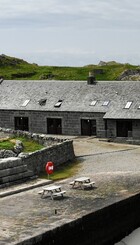
Lighting Up the Shore Station - a sustainable Hub for Tiree
2025-05-27 • No comments • • Regeneration Capital Grant Fund
1 We would like to refurbish Alan Stevenson House (ASH) to offer a locally inspired restaurant, bar with 6 ensuite rooms (1 disabled). We would like to upgrade the Harbour with pontoons and seating/viewpoints to take in the wonderful natural environment and encourage people to come by boat to the site in the summer months. Morton Boyd Hall (MBH) is an excellent multi purpose facility that just needs some upgrading and could complment any activities going on at the site. The site at Hynish, with its heritage and special quality of place, has the opportunity to develop its local hospitality and develop something of a Hub for the southern end of the island. Capturing tourism and events spend, alongside island/day visitor spend would provide a revenue stream.
2 The Skerryvore Shore Station was transferred to the Tiree community in January 25. The transition has taken 3 years. There are 3 income streams - Housing, Heritage and Business - that will ensure it is a sustainable community organisation going forward. We have been reviewing the use of our 20+ A listed buildings to ensure they are fit for purpose and revenue earning where possible. ASH was first rebuilt in 1990 as a hostel type accomodation for groups with special needs. it was only used for a few weeks in the summer months and was always a overhead for the charity. MBH had been used to house the exhibition/museum but originally had been rebuilt as a multi purpose hall. The harbour stands strong against the incredible tides and weather. It is a viewpoint for sealife and birds. The community when asked what they would like to see at the site in our survey and subsequent community events were clear that Business should be a priority. 84% said that they wanted a restaurant/cafe, quality accomodation and event space all year round. They also wanted the Harbour preserved. So our community mandate was clear. We have piloted the restaurant and rooms over the past 2 years and now believe that it could definately work if we had a good standard of accomodation to offer and a multi purpose space for events. We have moved the exhbition to another building to free up Morton Boyd Hall so that we have a this multi purpose facility. We will then be able to work with community groups to put on a variety of events and functions during the year. We will also be able to provide permanent employment for locals.
3 We can already see from our pilot that our community is very positive about the fact we have a local family working at ASH and have created year round employment for locals. We have trialled a number of community events over last winter and they proved to be very popular. The Tiree people just love the shore station and feel a strong sense of guardianship. The pilot has also showed us that we could have a reasonable income stream from this. We now have some facts and figures to base our projections on which gives us confidence this is the right way forward. All the buildings at Hynish need to work and complement each other to ensure the "place" is kept in alignment. The pilot has demonstrated that the restaurant/rooms/bar and events do contribute greatly to this. The project would enhance the employment opportunities; keep a family with 3 children living on Tiree as they have jobs; provide the much needed income stream to ensure sustainability; reduce running costs; make the buildings all more energy efficient and in line with our aim to lower the carbon footprint and provice a place for people and business to floutish.
4 The project will start early in 2026 and be completed by November 2026.
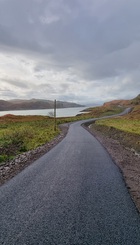.jpg)
Complete our lifeline link road!
2025-06-02 • No comments • • Regeneration Capital Grant Fund
In 2021 and 2022, IKDT secured funding to construst 1.79KM of brand new road connecting the North and South of the island. This project has been in the pipeline for many decades and has connected up the two different communities and is allowing our island to thrive as one. Just after we have secured the funding for the 2nd stage of the project, the tar topping, war broke out in Ukraine. Apart from the obvious humanitarian crisis, this had an instant impact on the price of all the raw materials required for surfacing. It meant we had to scale stage 2 back and make do with tarring the new built section of the road with a single layer of tar and leave approx 500 metres of road in an unbound, farm track state. Our plan for stage 2 had been to deliver 2 layers of tar over the new road (1.79km) and the 500m of existing road when we could petition the council to adopt the road as it connects up the existing council road to several council tax paying households. As it stands, while the road is in use and is hugely beneficial to life on the island however the maintenance burden on IKDT is not ideal. The council will not consider adoption until the road is brought up to the standard we had planned for stage 2 so we are hoping to complete the job. Adoption is key to the long term future of the road and indeed to whole community as it will allow unfettered access to all including vital services, emergency vehicles and access to the lifeline ferry service. The surfacing could be delivered in one week but the effects would be felt for generations to come. We would hope to continue the excellent working relationship with A&B Roads department to help deliver the best value for money possible.
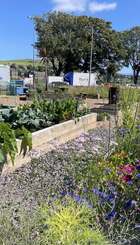
South Kintyre Growing Project
2025-05-29 • No comments • • Regeneration Capital Grant Fund
SKDT already operates the gateway garden (under licence from ACHA), as well as the putting green and herb garden (under licence from ABC) and the Robert Black Memorial Helipad (owner operator).
SKDT has well developed plans in place for these areas, which we would obviously like to see being well used by the community.
The creation of the Gateway Garden over the last 18 months has provided opportunities for food growing, education and intergenerational activity which are identified actions in the Campbeltown Community Action Plan (2022 – 2027). The Growing Project will also go some way towards developing local resilience and food security.
The initial redevelopment of the Gateway Garden, which is in a prominent location at the entrance to the town, has given impetus to other volunteers and potential gardeners to come forward.
Unfortunately, the limited size of the current garden area has restricted the number of growing plots available. The Growing Project would allow us to identify other suitable growing areas which we can develop in a gradual and progressive way, The, now ceased, Campbeltown Community Garden has donated their remaining plant and equipment to SKDT, now in storage, which will give us a head start in developing new growing spaces.
We also have a large selection of lawnmowers, gardening tools, hoses and other items which we can use for this project. However we will still need to acquire additional equipment and sundries (gloves, boots, compost, fertiliser etc) to allow us to proceed.
We will look to access additional funding to develop the project further via local funding through e.g. Common Good Fund, MACC and Campbeltown Community Windfarm Fund.
The main focus of this expansive project will be to attract, retain and train volunteers to get their hands dirty and get digging, weeding and planting.
As well as our own volunteers, there is another group of volunteers who have been looking after the bus terminal area. We will work alongside and support both of these groups. We will access additional training and advice from a network of community gardens throughout Scotland.
We would also continue and expand our work with the local schools on developing their own gardens and teaching kids the benefits of growing your own food. This would also allow for some important intergenerational activities which improve the lives of young and old.
We will also support and lobby for the provision of allotments for people to grow their own produce.
Unlocking Ulva: A Community Barge to Connect, Create and Thrive
2025-06-02 • No comments • • Regeneration Capital Grant Fund
North West Mull Community Woodland Company (NWMCWC) proposes to purchase and operate a community-owned barge to serve the Isle of Ulva. This transformative asset will unlock essential access for people, goods, vehicles, livestock, and materials - enabling regeneration, resilience, and economic growth on a fragile, remote island currently constrained by limited marine transport.
Ulva is a roadless island off the west coast of Mull, with no bridge and only a passenger ferry. The community is entirely reliant on the support of a local fish farm for occasional barge support - help that has been generous and invaluable over the last few years, though is naturally limited. This creates a significant barrier to regeneration, preventing progress on key projects and undermining the island’s long-term sustainability.
The barge will address this infrastructure gap and enable a range of community-led initiatives, including:
-
Heritage restoration, including the movement of scaffolding, stone, and tools to repair historic buildings like Ulva House or Telford-designed church, and other community buildings.
-
Sustainable land management, supporting crofting and farming by transporting livestock, feed, and agricultural supplies, as well as help with the removal of unused and broken equipment and machinery.
-
Resident-led business development, giving islanders the infrastructure needed to start and sustain their own small enterprises - enabling self-sufficiency and reducing dependence on external services.
-
Contractor and service access, allowing building and infrastructure work to proceed without excessive private transport costs.
-
Emergency resilience, offering an alternative logistics route in the event of ferry failure.
-
A community-led initiatives like Ulva Producers’ Market, connecting local growers, makers, and visitors in a shared island space.
-
Cultural and community events, such as pop-up exhibitions, and other events that require transporting bulky or heavy equipment.
As one resident said, "A community barge would secure the long-term future of the farm and ensure we’re no longer totally reliant on a third party to move livestock or machinery. It would also open up opportunities for diversification. On a personal level, it would create a more sustainable and flexible connection between Ulva and Mull—helping our community grow, thrive, and engage more with the wider community of north-west Mull.”
The barge will be community-owned, maintained by NWMCWC, and operated in partnership with residents and local businesses. It will have multiple uses and function flexibly, supporting both everyday needs and long-term community goals. Critically, it provides a foundation for further regeneration efforts, addressing a clear case of market failure and enabling transformational change.
The project will be ready to commence once capital funding is secured, with delivery anticipated over 12–18 months, including procurement, compliance, training, and launch.
